Exotic cantaloupe "Cantaloupe": an overview of a variety with an amazing taste and aroma
Melon is a tasty and healthy product that is considered a symbol of summer and relaxation. It is popular in all countries of the world, it is liked by adults and children. Many gardeners dream of growing a representative of melons on their site.
Most varieties are capricious in leaving and do not tolerate cold snaps. It will not be easy for beginners to cope with their cultivation in the conditions of our country. Melon Cantaloupe is an exception. This variety is suitable for growing not only in the southern but also the central regions.
The content of the article
Melon variety description
Cantaloupe is a melon variety that is more than 2 thousand years old. For the first time, its fruits were found in India and Guinea. Now this representative of melons is grown all over the world. On an industrial scale, it is cultivated in Thailand.
Cantaloupe is also called Thai, Butter and American melon. This variety is famous for its unpretentiousness and excellent taste.
It is interesting! The culture was brought to Europe from Asia during the Crusades. This melon has become the pope's favorite dessert. He ordered to grow it on his estates in Cantalupia. Thanks to this, Cantaloupe got its name.
Distinguishing features of Cantaloupe
Cantaloupe looks more like a pumpkin than a melon in appearance. Its fruits have a thick green or yellow rind that is covered with a brown, rough, mesh pattern. The melon pulp is juicy and aromatic, has a rich sweet taste and musky smell.
The photo shows the fruits of the variety.
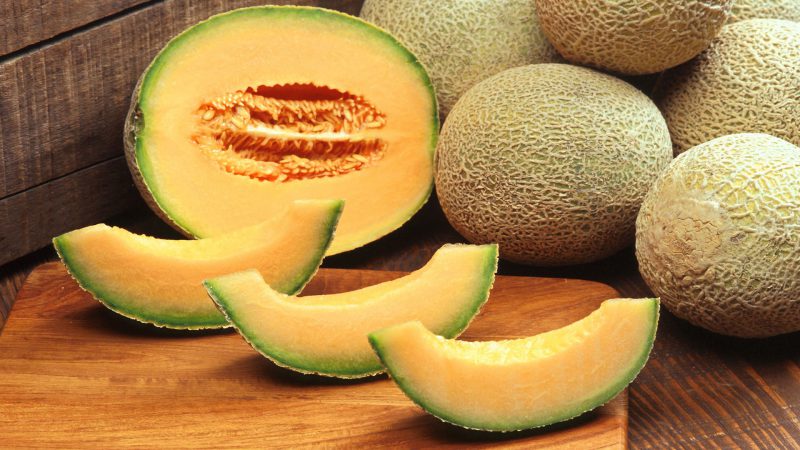
Cantaloupe differs from other varieties of melon in its small size. The weight of one fruit does not exceed 1500 g.
It is interesting! Melon fruits are called pumpkins.
The variety is distinguished by its unpretentious care. It has an average resistance to cold snaps, therefore it is suitable for growing in the central and southern regions of our country.
Another positive quality of Thai melon is immunity to diseases of melons. It does not have such a high resistance to infections as more modern hybrids, but diseases rarely affect it.
Melon health benefits
Melon Cantaloupe is prized not only for its rich aroma and refreshing taste, but also for its beneficial properties.
It refers to dietary products: per 100 g, there are only 34 kcal, 0.84 g of proteins, 0.19 g of fat and 7.25 g of carbohydrates.
Melon contains a huge amount of trace elements. Its fruits have a number of beneficial properties:
- choline stimulates brain activity and improves memory;
- beta-carotene removes toxins, toxins, free radicals and harmful cholesterol from the body, improves vision and stimulates the liver, has a positive effect on the work of the cardiovascular system;
- Zeaxanthin improves vision;
- potassium improves the condition of the cardiovascular system, normalizes blood pressure, has a beneficial effect on the condition of the skin and hair;
- inosine stimulates hair growth, cleanses the body of harmful cholesterol;
- folic acid has a positive effect on the general condition of the body, it is vital for pregnant women.
Main characteristics
Cantaloupe is an old and proven variety that still hasn't lost its popularity. It is with him that beginner gardeners should start their acquaintance with melons.
Description of Cantaloupe:
| Parameter | Index |
| Ground part of the plant | Stems are powerful, creeping.The root system goes deep underground and grows near the surface. Leaves are large, dark green, reminiscent of pumpkin. The number of female and male flowers on the bushes is approximately equal. |
| Fruit | Small in size. The weight of one pumpkin varies in the range of 1-1.5 kg, the diameter is 23-25 cm. The skin color is greenish or yellow. There are specimens with yellow and green stripes. The rind is covered with a brown or white mesh pattern. The shape is round-flattened, oval fruits are rare. The pulp is tender and juicy, bright yellow, light green or white. The taste is sweet with a musky aroma. The seeds are plentiful and suitable for growing. |
| Ripening terms | Mid-season. There are early hybrids bred on the basis of this variety. Fully ripe fruits are harvested at the end of August. |
| Yield indicators | Up to 8 pumpkins are harvested from 1 bush. In this case, the fruits will be small. Agricultural rules allow leaving 2-4 fruits on each plant |
| Transportability | Average. The hard rind allows the melon to be transported over long distances, but it is stored for no more than 3 weeks, even in a cool place |
| Growing conditions | In the southern regions, it is cultivated in the open field. In central ones - in greenhouses or under film shelters. |
| Immunity | Average resistance to diseases of melons. |
It is interesting! Breeders in the USA have grown many hybrids based on Cantaloupe. Cantaloupe yellow f1 is the most popular of them.
How to choose fruits when buying
Cantaloupe is one of the tastiest melon varieties. Unripe fruits have a watery taste and unsaturated aroma.
When buying this melon in markets and stores, you should adhere to three rules that will help you check the quality of the goods:
- Crust. It should not have dark spots, dents or other damage. The main shade in ripe fruits is off-white, yellow or striped. The pumpkins are dense and hard to the touch.
- Peduncle. It should not be on ripe fruits, as in this case it is easily separated.
- Aroma. Smelling ripe Cantaloupe, the customer will feel a sweet musky scent. The smell is most pronounced at the stalk. If there is no aroma, but there is a moldy smell, such melons are not worth buying.
How to grow this variety yourself
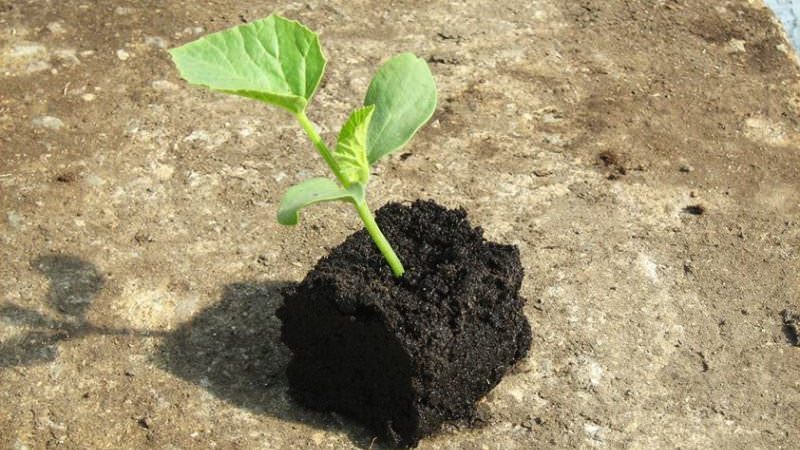
Melon is a thermophilic culture. The most illuminated part of the garden is chosen for her. It is better if the beds are located on a hill so that water does not accumulate in the roots of the plants.
It is important to choose the right melon predecessors. The beds on which other melons and gourds (pumpkins, cucumbers, watermelons, zucchini) were grown over the past 2 years will not work. Best of all, Cantaloupe feels in the area of the garden, where legumes, root crops, nightshade and cereal plants, cabbage, and any greenery grew before.
A slightly acidic, loose and fertile soil is suitable for melons. They begin to cook it in the fall.
The beds are dug up and cleaned of plant residues. 8 kg of humus are applied per 1 m². To reduce acidity, soil is mixed with ash. Sand is used to lighten the composition of the soil.
In the spring, the soil is dug up again and cleaned of weeds. 30 g of superphosphate, 15 g of ammonium nitrate and potassium sulfate are added per 1 m². Then they are disinfected by pouring a solution of copper sulfate.
Holes 25-30 cm wide are dug in rows. It is important to maintain a distance of at least 1 m between the grooves.
Landing
Melon is grown in a seedling and non-seedling way. The first option is considered optimal, since it guarantees full ripening of the fruits before the first frost.
Whichever melon cultivation option is used, the seed treatment process will be the same. The preparation will accelerate the germination of planting material and increase the resistance of plants to adverse environmental factors:
- Selection of planting material. For planting, choose dense seeds with a uniform color.
- Seed dressing.To do this, they are dipped in a light pink solution of potassium permanganate for 30 minutes or in hydrogen peroxide for 15 minutes. After that, the planting material is washed under running water.
- Growth stimulation. To accelerate the germination of seeds, they are soaked for a day in a special solution ("Epin") or home remedies (aloe juice). The container with seeds is placed on a radiator or in a warm place so that the liquid does not become cold.
Advice! For cultivation, it is better to use seeds not from last year's harvest, but from fruits harvested 2-3 years ago. Fresh planting material will produce plants with many male flowers and few ovaries.
Seedling method
Peat pots are used to grow melons. They are used only once, so they do not need disinfection.
Seedlings begin to grow in mid-April. The plants will be ready for planting in 4-5 weeks.
When preparing the soil for seedlings, peat and humus are mixed in equal proportions. Add half a portion of sand and a glass of ash to the composition.
Basic rules for growing:
- Seeds are planted in warm soil. To do this, it is kept at room temperature for 2 days.
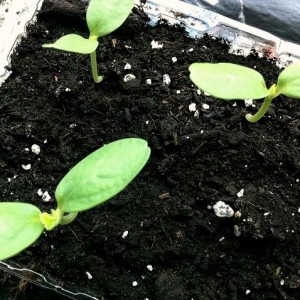
- The earth is scattered in pre-prepared pots. Before planting seeds, it is watered with warm water.
- 2 seeds are sown in each container. They are buried 2-3 cm, sprinkled with soil, covered with foil and removed to a warm place before germination.
- After the first shoots appear, the film is removed, the seedlings are rearranged on the windowsill. It is watered as the soil dries up with water at room temperature.
- For the entire period of growing seedlings, 1 top dressing is applied. Chicken droppings are used, diluted with water in a ratio of 1:10. For 5 liters of this composition, it is recommended to add 2 tbsp. l. ash and 1 tbsp. l. superphosphate.
- It is recommended to start hardening the pumpkin a week before planting in a permanent place. For this, the plants are taken out into the street in the warm season.
- Before planting, 1 liter of water is poured into each hole. They also add 1 tbsp. l. ash and 25 g of superphosphate.
- Plants are planted one at a time in each well. If both seeds germinated in the pot, then pinch the weak stem. When planting, the root collar is not buried, but left to rise slightly above the ground.
After planting seedlings in open ground, for the first time at night, it is covered with a film to protect it from frost. In the central regions, it is recommended to grow the melon in a greenhouse.
Seed method
The seed method is only suitable for southern regions. In this case, the harvest will appear much later.
Seeds are sown in open ground in the second half of May. By this time, the soil temperature should not be lower than +18 ° C (measured at a depth of 15 cm).
A layer of humus or rotted manure is poured into the bottom of the prepared hole. The same layer of soil is poured on top. The layers are mixed. The rest of the space is filled with ordinary garden soil.
In each well, 2 seeds are sown as far as possible from each other. They are buried 5-6 cm and watered with warm water.
Crops are covered with foil until germination. The film is removed daily for airing. When the first true leaves appear on the plants, the greenhouse is dismantled or left before flowering.
When the plants grow up, pinch the weaker stem. Some gardeners prefer to leave 2 plants in 1 hole at once.
Growing features
Cantaloupe is adopted only if it gives a large number of shoots. To obtain large and tasty fruits on one plant, it is recommended to leave 2-3 side stems.
Watering should be frequent and abundant. Use water at room temperature. It is poured not directly under the root, but into the prepared recess near the hole. Some gardeners prefer to pour liquid into the grooves dug between the rows.
After each watering, the soil is loosened. In the process, the beds are cleared of weeds.
Advice! Experienced gardeners recommend mulching melon beds with rotted sawdust, peat or straw.Such a layer will not only protect the roots from freezing and pests, but also slow down the growth of weeds.
During the entire growing period, the melon is fed twice. Nitrogen fertilizers are used before flowering. When forming flowers, potassium and phosphorus are added once.
Possible difficulties
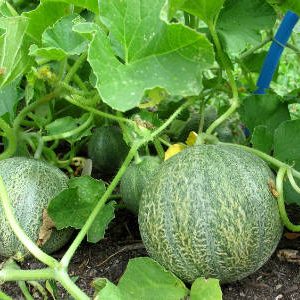
When growing melons, novice gardeners often face a number of difficulties. The list contains the most popular:
- Leaves wither in hot weather. This means that the number of watering needs to be increased, and in the morning, the bushes should be sprayed with warm water.
- Few ovaries are formed. Artificial pollination will help. For this, male flowers are applied with stamens to female ones.
- The fruits are small and ugly. Reduces the number of ovaries. 2-4 fruits are left on one plant.
Diseases and pests
Cantaloupe is immune to diseases of melons. According to gardeners, infections rarely affect it, but this happens.
Most often, the melon suffers from root rot and powdery mildew. To avoid contamination of plants, it is important to disinfect all gardening tools, follow the rules of watering and crop rotation, and do not plant other melons and gourds next to the pumpkin.
As a more serious prophylaxis, plants are sprayed with Bordeaux liquid or light pink potassium permanganate solution. These funds will also help at the very beginning of the development of diseases. Bushes that are completely damaged by infection are removed and burned.
To protect the melon from pests, sprinkle its leaves with tobacco. It is useful to spray the ground part of the plant with soapy water (1 bar of soap per bucket of water).
Harvesting and application of the crop
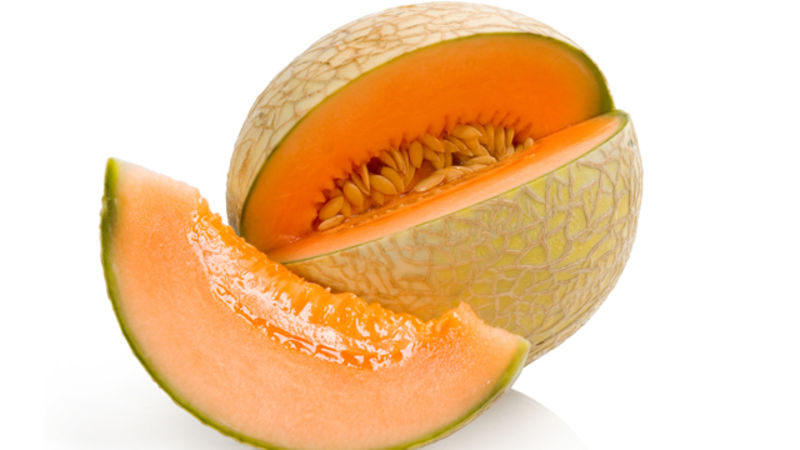
Melons are harvested in late August and early September. Only fully ripe fruits are picked, since they do not ripen at home.
The maturity of Cantaloupe is determined by the following criteria:
- the stalk is easily separated from the fruit;
- a strong musky aroma emanates from pumpkins;
- if you knock on a ripe melon, you will hear a dull sound.
Cantaloupe is mostly consumed fresh... It makes delicious candied fruits, dried chips, boiling.
Advantages and disadvantages of the variety
Benefits of Cantaloupe:
- rich aroma and pleasant taste of the fruit;
- portioning of pumpkins;
- immunity to diseases of melons;
- unpretentious care;
- not prone to cracking;
- the possibility of using seeds for planting.
The disadvantage is the short-term keeping quality of the melon. It is stored for no more than 3 weeks.
Conclusion
Melon Cantaloupe is one of the most unpretentious varieties to grow. She is not afraid of high humidity, has immunity to various infections and is resistant to cold snaps.
Low maintenance is not the only advantage of Cantaloupe. This variety is famous for its small but tasty fruits with a rich aroma. It is from Cantaloupe that gardeners should start their acquaintance with melons.